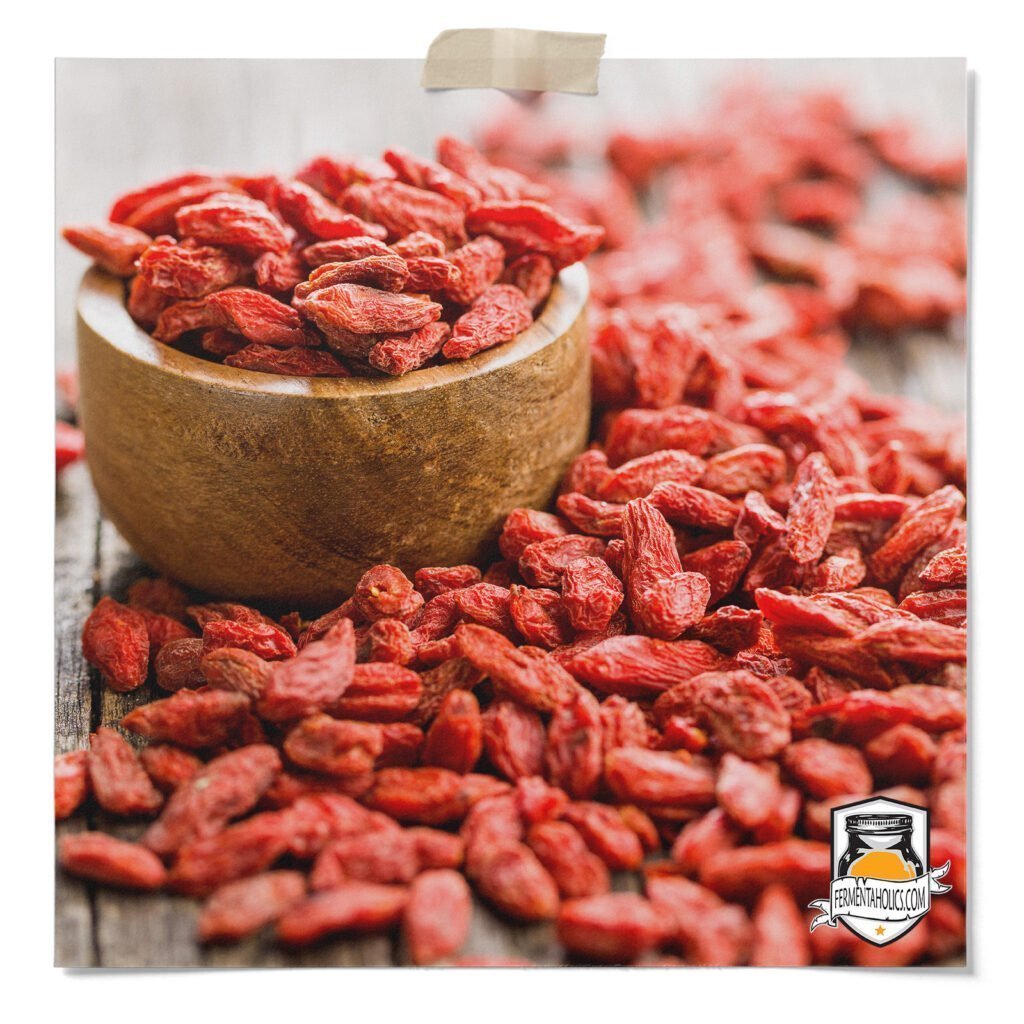
I can see some of your faces cringing when you read the words peanuts and kombucha in the same sentence. It’s like trying peanut butter and jelly on a hamburger. Super mind blowing. It shouldn’t work together but somehow it really does. Goji berries somewhat pioneered the super food movement. Slapped full of antioxidants and vitamins, these little guys pack a seriously nutritious punch. I can’t think of any reason to not add them to kombucha. They don’t add much to the color, but they sure do add a lot of flavor and nutrients. And talk about fizzy kombucha, holy cow! You will DEFINITELY need to burp this daily. I popped this open and a peanut (well several) shot right out and hit my friend in the head!! ha! Be forewarned. Peanuts are a strange character to say the least. Some people, actually many people, are highly allergic to them. Others are not affected at all. I wonder if fermentation does anything to the proteins that cause allergic reactions? Anyone know anything about that?
In flavoring kombucha, the peanuts come through extraordinarily strong. It almost reminds me of putting peanut butter in a smoothie, no hiding it. They also add a saltiness factor which, strangely enough, goes well with kombucha! Not sure if I would do just a plain peanut kombucha because it may be too strong without some sweetness backing it up. Maybe I would use it for smoothies only or something. For this kombucha, all I did was take salted peanuts that were already out of the shell and kind of twisted each with my fingers so they split in half and would fit in the bottle better. Then I added a small handful of dried goji berries. It was really simple, especially because both of these items are pantry items and can always be there for you.

It’s important to note that making homemade kombucha is almost always a two-step fermentation process. Brewing kombucha is only a one-step process for those who prefer an unflavored flat kombucha. Otherwise, the steps consist of a primary fermentation and a secondary fermentation.
Primary fermentation is the first step of the kombucha brewing process. This is where your SCOBY transforms regular sweet tea into the tart and slightly sweet kombucha we love. At the end of this stage, you will have finished kombucha, but it will be flat and unflavored. Have you skipped this step? Then check out our guide on how to make kombucha at home, and for jun kombucha, see our post on how to make jun kombucha tea at home. Traditional kombucha is going to yield a bolder brew, while jun kombucha is milder and can be a bit tarter.
Secondary fermentation is the step where you bottle, carbonate, and flavor your kombucha with the addition of sugar and flavors. In this step, the finished kombucha from the primary is mixed with sugar, fruits, or other flavors before bottling it with specialized lids that can hold pressure, like flip-top bottles. The bottled kombucha is then left at room temperature for natural fermentation, where yeast carbonates the kombucha within the sealed bottle. The ideal temperature range for this process is between 75-85°F. The amount of time needed to carbonate within the bottle is highly tied to temperature, which can take anywhere from 2-10 days.
💡Since this recipe is for the secondary fermentation, to make this recipe, you’ll need to have kombucha that has finished the primary fermentation and is ready to bottle.
This recipe makes one 16-fluid-ounce bottle. A 1-gallon batch of kombucha will make seven 16-ounce bottles, so for one gallon, you will need to multiply the ingredients by 7. Before beginning this recipe, you will need to:
10
2-10 Days
This Goji Berry and Peanut Kombucha recipe is for seven 16 fluid ounce bottle. Before bottling your kombucha, remove the SCOBY pellicle along with 12-16 ounces of kombucha starter tea from your brew, and reserve for your next batch.
3.5 Cups Shelled, Salted Peanuts
6 TBSP Dried Goji Berries
1 Gallon Fermented Kombucha
16 Oz Swing Top Bottles
Small Strainer
Small Pot
Take the little peanuts between your fingers and sort of twist them so they break into halves, then add them to the bottle.
Pop in all the goji berries.
Fill each bottle with kombucha, leaving about an inch of head space.
Be sure to leave yourself enough kombucha to use as your starter for the next batch, about 2 cups per gallon.
Tightly place caps on each bottle.
Keep bottles at room temperature for 2-10 days, depending on temperature.
Once per day, you’ll want to “burp” the bottles by removing the cap to allow built up pressure to escape and place the cap back on. As soon as you put the cap back on, the carbonation will begin to build back up, so no worries of it getting flat. Try not to skip this or you will have kombucha all over your face and your kitchen when you do go to open it.
When you are happy with the flavor and fizziness of your kombucha (1-3days), place bottles in the fridge to chill and halt the fermentation.
